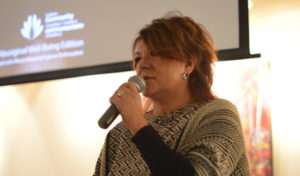Vital signs for First Nation Well-Being in the City of Greater Sudbury

By Heather Campbell
SUDBURY—This year, the Sudbury Community Foundation’s 9th edition of the Vital Signs Report had a special focus on Aboriginal Well-being in the City of Greater Sudbury. The city includes two First Nation communities, Atikameksheng Anishnawbek and Wahnapitae First Nation, with a total population of 13,410 First Nation people living in Sudbury.
The report was presented at a luncheon on Tuesday, October 4, with a panel discussion chaired by Martin Bayer, partner and head of Aboriginal Law Group of Weaver Simmons LLP, in Sudbury; Dr. Pamela Williamson, executive director, Noojmowin Teg Health Centre; Kevin Fitzmaurice, associate professor of Indigenous Studies, University of Sudbury; and Suzanne Shawbonquit, owner of Sage Management Solutions and Crafty Chix.
The report stated that the intention was to raise awareness about the gaps in employment, health, housing, and education. Martin Bayer, Honourary Chair for the Special Edition says he wants to see more steps taken to address the gaps.
Areas of concern that arose from the findings include economic success of First Nation people. The report states that the 2011 Census indicated that “of the 13,405 Aboriginal people living in Sudbury, 3,565 had household incomes over $40,000, with the majority considering Sudbury to be home. However, many respondents were ‘critical of the many ways in which Canada has not lived up to its treaty obligations.”
Since 1981, there has been a consistent 20 point gap in well-being scores between First Nation and non-First Nation communities. In 2011, the average Community Well-Being score was 79 for non-First Nation communities and 59 for First Nation communities. The Community Well-Being index for the two First Nation communities in the Sudbury area are higher than both the national and provincial average for First Nation communities.
The report also states that “the path to economic success is attributed to a culturally strong and committed family support system that accompanies an individual throughout life.” However, discrimination and systemic racism continue to be an ongoing issue and that is where the panel members encouraged their audience to be part of the action to address.
“I would like for people to have a deeper understanding of us as Anishnaabe people and ask ‘why do those stats still characterize our communities?’,” said Bayer. “Otherwise it’s just another report.”
Bayer says he would like to see more public sector workers required to obtain a basic understanding of our treaty that allowed settlement of this community.
Panel member Shawbonquit who lives in Atikameksheng Anishnawbek and ran in the 2015 Sudbury by-election as the NDP candidate, shared with the audience that there needs to be change and they need to be part of that change.
“The study has indicated that Aboriginal people in the area want to be engaged,” stated Shawbonquit. “They want to sit on boards, and young people want to explore entrepreneurship, but racism is still present and Aboriginal people are still undervalued for their contributions.”
As recommendations are being implemented from the Truth and Reconciliation Report across the country, the Sudbury Community Foundation hopes that the Vital Signs Report can contribute to greater awareness and action in the Sudbury area.


